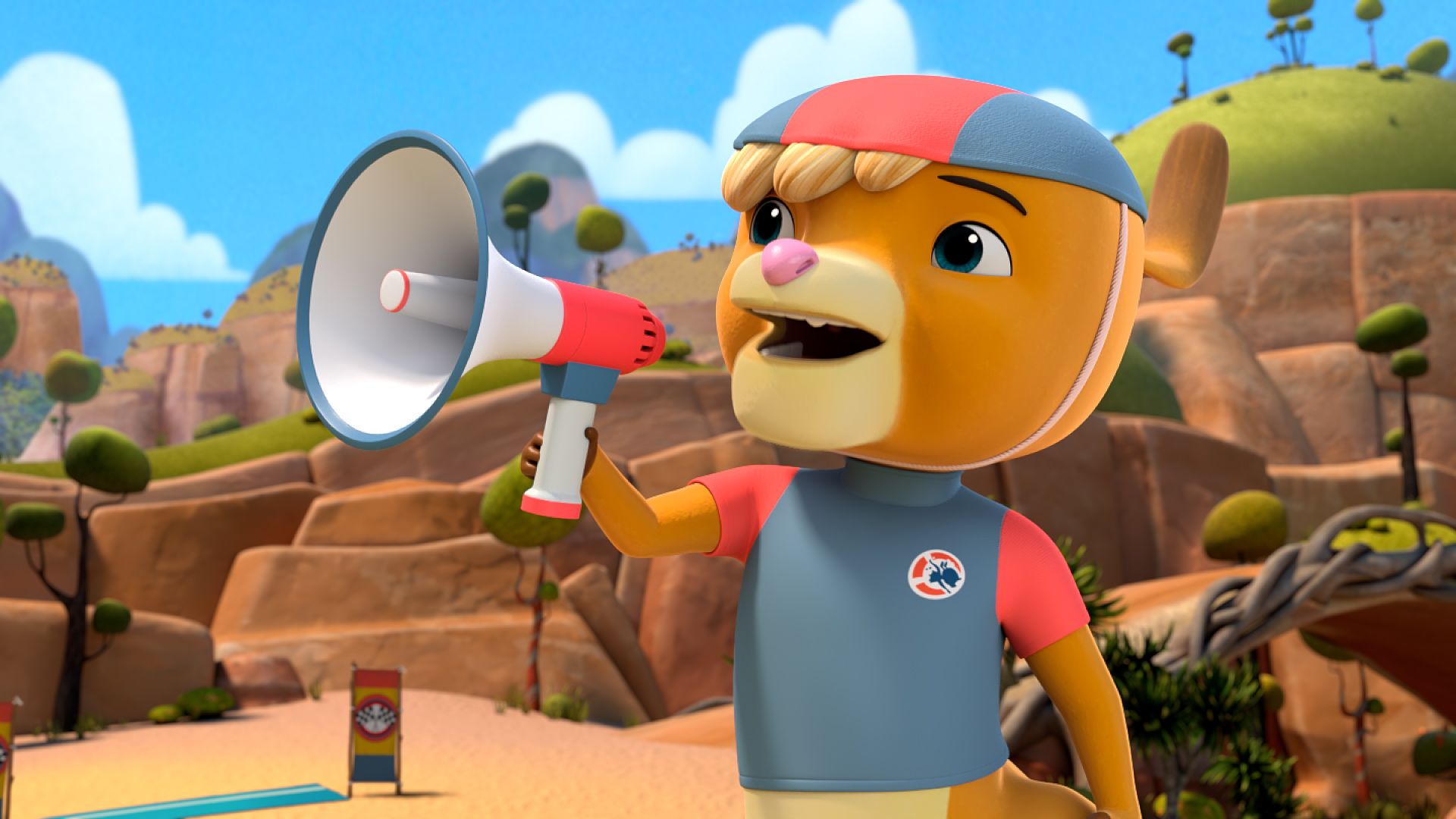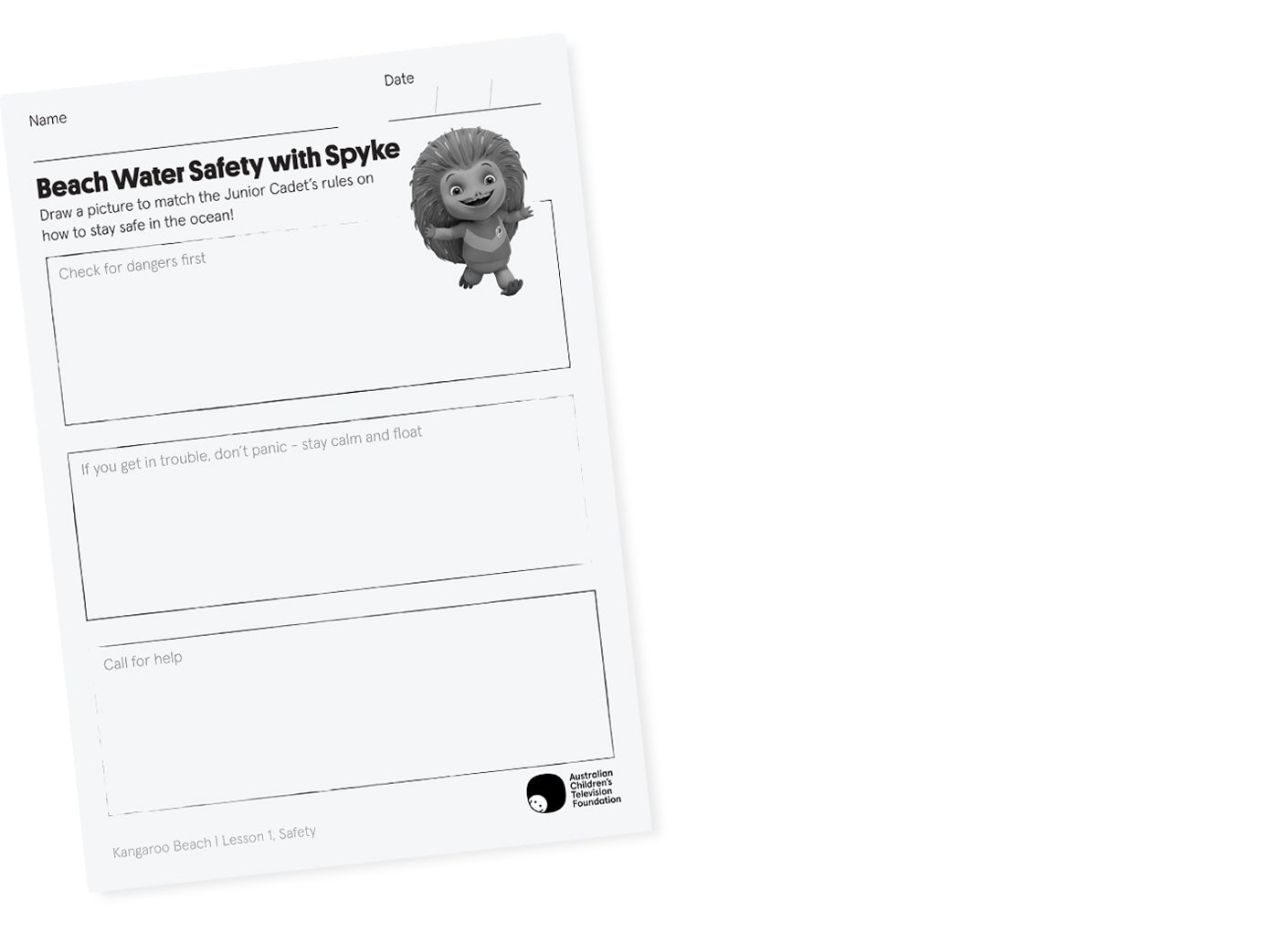
Lesson 1: Safety

Learning intention: In this lesson, you will learn some safety rules and movement skills that help keep yourself and other people out of danger when swimming at the beach.
Task 1: Water Dangers
Watch
Reflect
Turn and talk to a friend about these questions. Then, share your answers back to the group.
- Spyke forgets to check the water before going in. What two dangers does she miss?
- What happens once Spyke gets stuck in the water? What should she do instead?
- What does Gemma mean when she says, “The more we know, the more fun we can have?"
Create
Use your drawing skills to complete the reflection activity sheet that covers the important rules that Spyke and the Junior Junior Cadets must follow in order to be safe at the beach.

Task 2: Floating and Sinking
Watch
Reflect
Thinking about the clip from Kangaroo Beach, turn and talk to a partner about these questions.
- What are the three important rescue skills that a Junior Cadet must be able to do?
- What does Spyke do instead of those three things?
- What is a floatation device? Why is it so important in a rescue?
Then, share what your partner says about these questions back to the group. This is a good test of your listening skills – were you paying attention to what your partner said, or like Spyke, did you forget to listen?
Explore
Conduct a Sink or Float experiment using small objects you can find. Draw up a T-Chart in a workbook or on some paper. One side says Float, the other says Sink.
Fill a sink or large plastic container with water. Collect a variety of small objects and materials. Put them into the water and record them on the side of the chart according to whether they sink or float.
Note: Make sure that any objects used are clean and safe. If you need help thinking of good things to try, consider: pencils, erasers, clips, plastic and wooden rulers, crayons, lids, sponge or foam, coins, rocks, twigs, fabric, marbles, blocks, leaves, foil, elastic bands, a bit of fruit, an empty water bottle.
Remember: always fully drain all the water out of any container at the end. You might want to pour it on the garden, so it isn’t wasted.
Create
Based on your floating and sinking experiment, design your own floatation device for the Junior Cadets to use in a rescue. What materials will you use? How will it be used – do you wear it, hold it, or sit on it? How big should it be? Draw and label your designs. Share your designs with your group and evaluate / provide feedback to others on their ideas.
Task 3: Rescue Skills Physical Challenge!
Explore
In this episode, the Cadets use rescue boards. Here are some moves you can practise on land which make paddling and kneeling easier, and improve your balance and strength in the water.
Pounce Paddle Arms
Basic: Find a stable desk. Stand about one step back from it. Place your hands flat on the desk's edge, shoulder-width apart. Lean your body forward, so your nose nearly touches the desk. All your weight is in your hands. Push yourself back to the upright position. Tip: Check you have enough space when doing these for your legs to be straight.
Advanced: Do the same thing, but against a wall instead of on a desk.
Aim for 5-10 push ups per set, and 1-2 sets is a reasonable goal to start with. Take it slowly. It’s more important to do it correctly, than do it fast or do too many. Ask a friend or teacher to make sure your back is straight and your bottom does not stick out.
Sandy’s Tall Kneel Get-Ups
Basic: Kneel ‘up’ tall, so both shins are on flat the ground but your bottom is not resting on the back of your legs. Raise one leg up and put the foot flat on the ground. Push using that leg to stand all the way up. Do not use your hands. Return to tall kneel position. Do this over and over, gradually getting faster.
Spyke’s Sitting Get-Ups
Basic: Start off by taking off your shoes and sitting on the ground with your legs out in front. Get up to standing without using your hands – or crossing your legs. Then get down to sitting again.
Advanced: Take off a shoe and sit holding it over your head. Now, try doing the same Sitting Get-Up as above, but keep that shoe above your head the whole time.
Reflect
To improve at these exercises, start by counting how many you can do correctly right now. Set a goal, such as doing 10 push-ups, and each day try to add one more than the day before. Write down your daily numbers and track your progress.
For the tall kneel and sitting get-ups, track how many you can do in a set time, like 30 seconds, and try to increase that number over time, always focusing on maintaining good form.
Task 4: Danger Scene
Watch
Create
Spyke and the Junior Cadets perform a scene to help their younger friends understand the important water safety lesson. Make up your own scene. Find some simple props using equipment that you have nearby. Combine all the ideas about rescues and water safety that you have learned in this episode. Share your performance with an audience – maybe your whole class or some younger children you know.
Reflect
While you perform, have the audience members award the scene a ‘star’ for every clear water safety rule they can see and hear in the role play. They should include:
- Check the water first before you go in
- Don’t panic if you get in trouble in the water - stay calm and float
- Call for help
- Always use something that floats for a rescue
- and maybe more
Which group has the clearest performance of the most messages and achieves the most ‘stars’ from the audience?
Australian Curriculum Links
|
|
Foundation |
Year 1 |
Year 2 |
|
Movement and physical activity: Moving our bodies |
practise fundamental movement skills in minor game and play situations demonstrating how to transfer weight from one part of the body to another
experiment with different ways of moving their body safely and manipulating objects and space suggesting and testing … different ways to use equipment and objects, and making judgements about which are most effective manipulating equipment… in imaginative play |
practise fundamental movement skills and apply them in a variety of movement situations
investigate different ways of moving their body, and manipulating objects and space, and draw conclusions about their effectiveness using different types of equipment to … solve a movement challenge and evaluating the solution against a set of criteria |
|
|
Making healthy and safe choices |
identify health symbols, messages and strategies in their community that support their health and safety recognising and following safety symbols and procedures at home and in water … environments exploring different community strategies that keep children safe; for example… safety procedures at swimming pools and beaches |
investigate a range of health messages and practices in their community and discuss their purposes identifying and rehearsing strategies they can use when requiring assistance exploring how characters in texts use … help-seeking strategies to keep themselves and others safe |
|
Australian National Benchmarks for Swimming and Water Safety
|
|
Fundamental Stage |
Acquisition Stage |
|
Milestone |
Identify people and actions to help in an aquatic emergency |
Recognise and support an emergency |
|
|
Fundamental Stage |
Acquisition Stage |
|
Milestone |
N/A |
Be rescued by a non-swimming rescue technique Rescue a person using a non-swimming rescue technique |
|
|
Fundamental Stage |
Acquisition Stage |
|
Milestone |
Identify rules for safe behaviour at aquatic environments at or near the home |
Understand and respect safety rules for a range of aquatic environments Identify hazards in a range of aquatic environments |